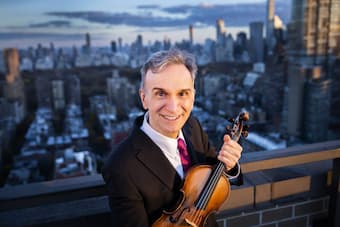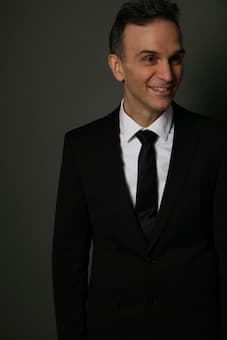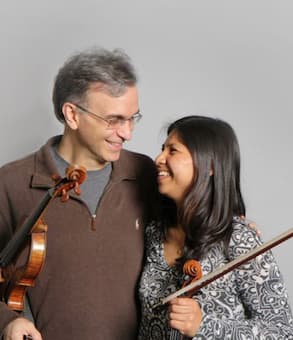
Gil Shaham © Chris Lee
Gil Shaham is rightfully considered one of the foremost violinists of our time. Born on 19 February 1971 in Champaign-Urbana, Illinois, his playing combines inimitable warmth and generosity of spirit. Musical America named him “Instrumentalist of the Year 2012,” and he received a Grammy Award for his collaboration with André Previn on “American Scenes,” featuring works by Copland, Previn, Barber, and Gershwin, in 1999. Shaham is highly sought after throughout the world for concerto appearances with leading orchestras and conductors, and he regularly presents recitals and appears with ensembles on the world’s great concert stages and at the most prestigious festivals. His playing has been described as “conveying the full and varied flavor of music…with a tone that ranges from sweet to the incisive, but laying out the mechanics of this music with rare clarity. He finds meaning in everything without feeling the need to project overt expression onto it.”
Gil Shaham Plays Bach’s Chaconne
 Gil Shaham was born in the United States while his Israeli parents were on an academic fellowship at the University of Illinois. His father Jacob was an astrophysicist and his mother Meira Diskin a geneticist and pianist. When he was two, his family moved to Jerusalem and Gil started his violin lessons at the Rubin Academy of Music. The Jerusalem Conservatory of Music was founded in August 1933 by violinist Emil Hauser, who also served as its first director. In 1958, the president of the now “American-Israel Cultural Foundation” Samuel Rubin, donated a large sum of money towards the purchase of a building that still carries his name today. Gil Shaham entered the institution at the age of seven, winning annual scholarships from the American-Israel Cultural Foundation, and studied with Samuel Bernstein. He made his orchestral debut with the Jerusalem Symphony at age 10, and performed with the Israel Philharmonic under Zubin Mehta shortly thereafter.
Gil Shaham was born in the United States while his Israeli parents were on an academic fellowship at the University of Illinois. His father Jacob was an astrophysicist and his mother Meira Diskin a geneticist and pianist. When he was two, his family moved to Jerusalem and Gil started his violin lessons at the Rubin Academy of Music. The Jerusalem Conservatory of Music was founded in August 1933 by violinist Emil Hauser, who also served as its first director. In 1958, the president of the now “American-Israel Cultural Foundation” Samuel Rubin, donated a large sum of money towards the purchase of a building that still carries his name today. Gil Shaham entered the institution at the age of seven, winning annual scholarships from the American-Israel Cultural Foundation, and studied with Samuel Bernstein. He made his orchestral debut with the Jerusalem Symphony at age 10, and performed with the Israel Philharmonic under Zubin Mehta shortly thereafter.
Gil Shaham Plays Tchaikovsky’s Violin Concerto in D Major

Gil Shaham and Adele Anthony
Shaham won first prize in the Israeli Claremont Competition at the age of 11, which granted him a scholarship to the Juilliard School in New York. “On that day,” Shaham recalls, “I thought of giving up the violin and becoming an electrician. I arrived thinking I was somebody and found a hundred Itzhak Perlmans my own age… It was an unforgettable, invaluable lesson in humility.” Gil studied under Perlman’s teacher, the legendary Dorothy DeLay, and his international breakthrough came in 1989. When Perlman cancelled an appearance in London, Shaham was called to step-in on short notice. “Just the idea of traveling on the Concorde and getting out of reciting The Canterbury Tales for an English exam prompted me to accept immediately,” Shaham remembered. ”Barely ten minutes before the concert, I realized the audience expected Perlman and not me to play the Sibelius and Bruch Violin Concertos, and that’s when I wanted to run back to school.” Nevertheless, a critic wrote, “Shaham produced a pure, radiant sound, suave in softer passages, bold and soaring in the louder ones. He may need a few years to develop his own interpretive style—the cadenza, for instance, was accurate but sterile-sounding—but he nonetheless infused his playing with considerable drama… In the encore, the young virtuoso presented artful phrasing and sure-footed control.”
Gil Shaham Plays Bruch’s Violin Concerto No. 1

© Chris Lee
With his reputation firmly established, Shaham built a stunning career based on “unfailing virtuosity and a big sound, full, deep and smooth…. unmistakably enriched by the legendary “Comtesse de Polignac” Stradivarius he plays.” Today, he manages his own music label, Canary Classics, and readily acknowledges that “these are ambiguous times for music in general, classical as well as popular… In a certain sense, the world of music is like that of journalism now. We share a future that’s uncertain but also fascinating.” Although an undisputed superstar of classical music, Shaham has kept his feet firmly on the ground. In fact, he has served as a role model for countless aspiring musicians. He was a child prodigy, but his parents never forced him, “but rather encourage him to do what made him happy. Neither was he a promotional product and, while at Juilliard, considered whether he truly wanted to follow the path of music.” Along the way he met and married the Tasmanian violinist Adele Anthony, and the couple teach at Bard College and have three children. According to a Classical Music Writer, “Shaham has grown and matured as a man and as an artist, yet remains the same likeable, honest and unaffected person I first interviewed 20 years ago.”
For more of the best in classical music, sign up to our E-Newsletter
Shaham/Abbado Perform Brahms’ Violin Concerto
